Civil Engineering: Sustainable Practices & Material Performance Report
VerifiedAdded on 2023/04/22
|20
|4162
|470
Report
AI Summary
This report addresses key aspects of civil engineering, focusing on material storage, sustainability, and building performance. It begins by examining safe and efficient storage practices for construction materials, emphasizing waste management and the proper handling of hazardous substances, referencing relevant regulations and ACOPs. The report then discusses cross-laminated timber (CLT) as a sustainable alternative, highlighting its recyclability, ease of deconstruction, environmental friendliness, strength, and reduced waste. A comparison of materials used in construction 50 years ago versus today underscores the shift towards sustainability. The report also analyzes the benefits and limitations of steel and concrete, suggesting bamboo as an alternative. Finally, it touches on evaluating building performance in terms of human comfort requirements. The document is available on Desklib, a platform offering study tools for students.

CIVIL ENGINEERING
By Name
Course
Instructor
Institution
Location
Date
By Name
Course
Instructor
Institution
Location
Date
Paraphrase This Document
Need a fresh take? Get an instant paraphrase of this document with our AI Paraphraser
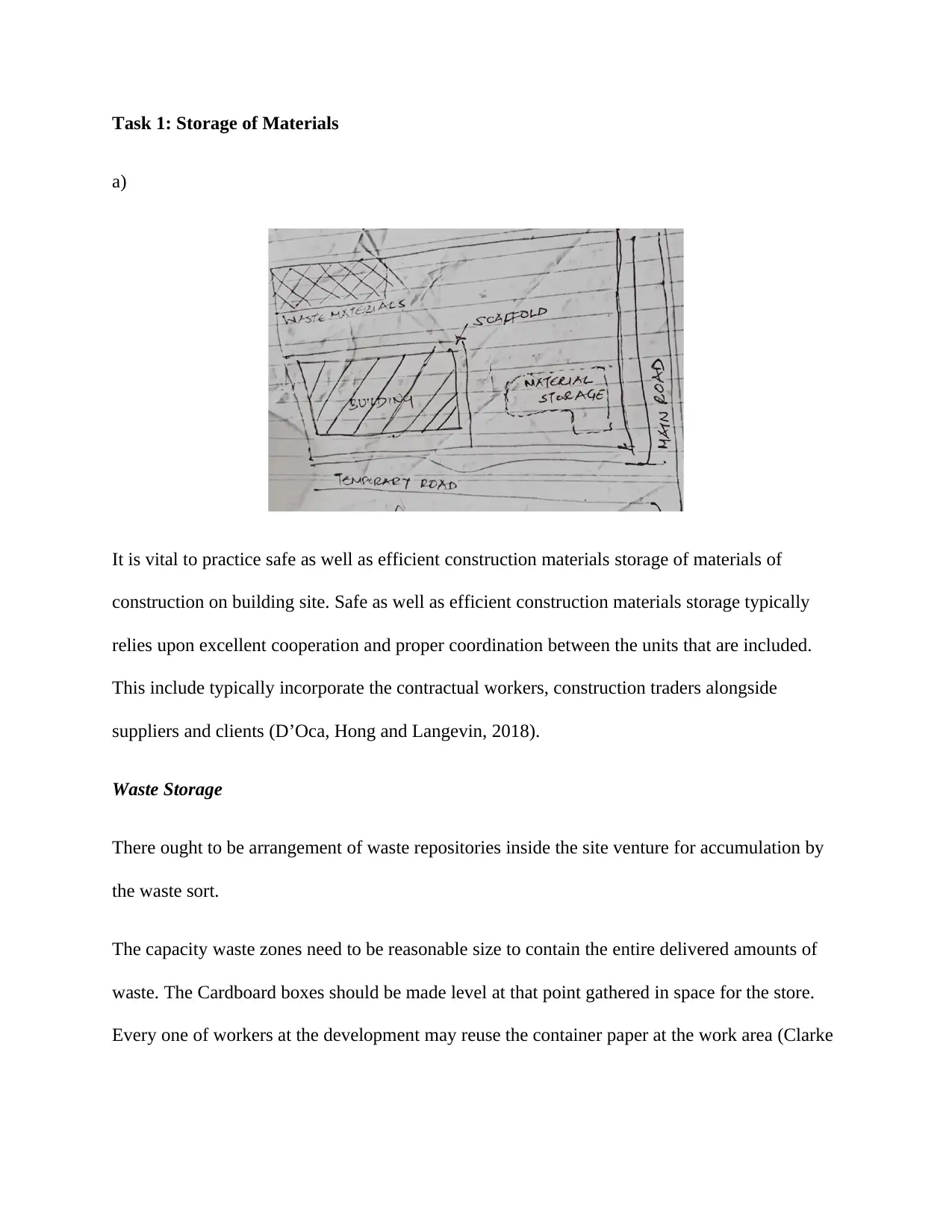
Task 1: Storage of Materials
a)
It is vital to practice safe as well as efficient construction materials storage of materials of
construction on building site. Safe as well as efficient construction materials storage typically
relies upon excellent cooperation and proper coordination between the units that are included.
This include typically incorporate the contractual workers, construction traders alongside
suppliers and clients (D’Oca, Hong and Langevin, 2018).
Waste Storage
There ought to be arrangement of waste repositories inside the site venture for accumulation by
the waste sort.
The capacity waste zones need to be reasonable size to contain the entire delivered amounts of
waste. The Cardboard boxes should be made level at that point gathered in space for the store.
Every one of workers at the development may reuse the container paper at the work area (Clarke
a)
It is vital to practice safe as well as efficient construction materials storage of materials of
construction on building site. Safe as well as efficient construction materials storage typically
relies upon excellent cooperation and proper coordination between the units that are included.
This include typically incorporate the contractual workers, construction traders alongside
suppliers and clients (D’Oca, Hong and Langevin, 2018).
Waste Storage
There ought to be arrangement of waste repositories inside the site venture for accumulation by
the waste sort.
The capacity waste zones need to be reasonable size to contain the entire delivered amounts of
waste. The Cardboard boxes should be made level at that point gathered in space for the store.
Every one of workers at the development may reuse the container paper at the work area (Clarke
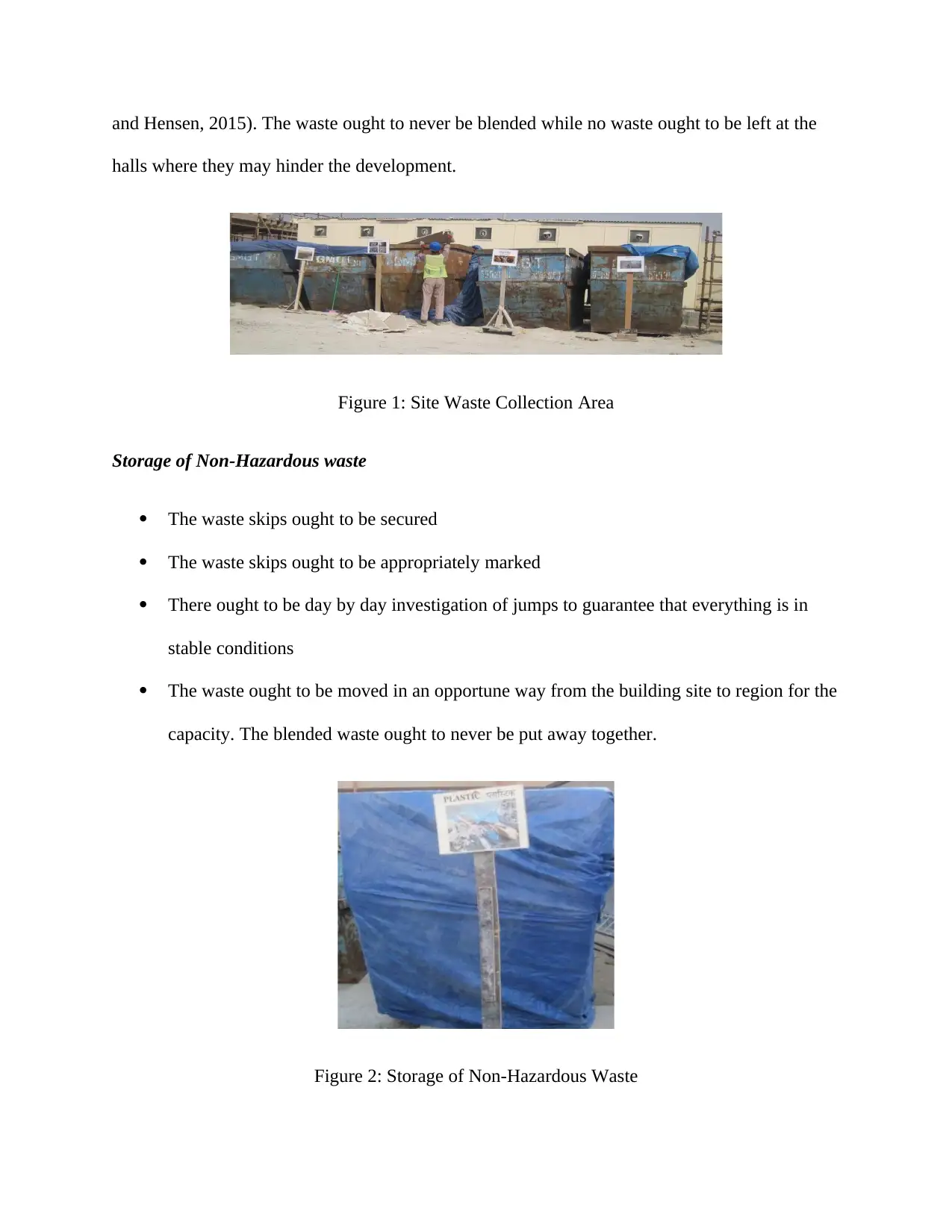
and Hensen, 2015). The waste ought to never be blended while no waste ought to be left at the
halls where they may hinder the development.
Figure 1: Site Waste Collection Area
Storage of Non-Hazardous waste
The waste skips ought to be secured
The waste skips ought to be appropriately marked
There ought to be day by day investigation of jumps to guarantee that everything is in
stable conditions
The waste ought to be moved in an opportune way from the building site to region for the
capacity. The blended waste ought to never be put away together.
Figure 2: Storage of Non-Hazardous Waste
halls where they may hinder the development.
Figure 1: Site Waste Collection Area
Storage of Non-Hazardous waste
The waste skips ought to be secured
The waste skips ought to be appropriately marked
There ought to be day by day investigation of jumps to guarantee that everything is in
stable conditions
The waste ought to be moved in an opportune way from the building site to region for the
capacity. The blended waste ought to never be put away together.
Figure 2: Storage of Non-Hazardous Waste
⊘ This is a preview!⊘
Do you want full access?
Subscribe today to unlock all pages.

Trusted by 1+ million students worldwide
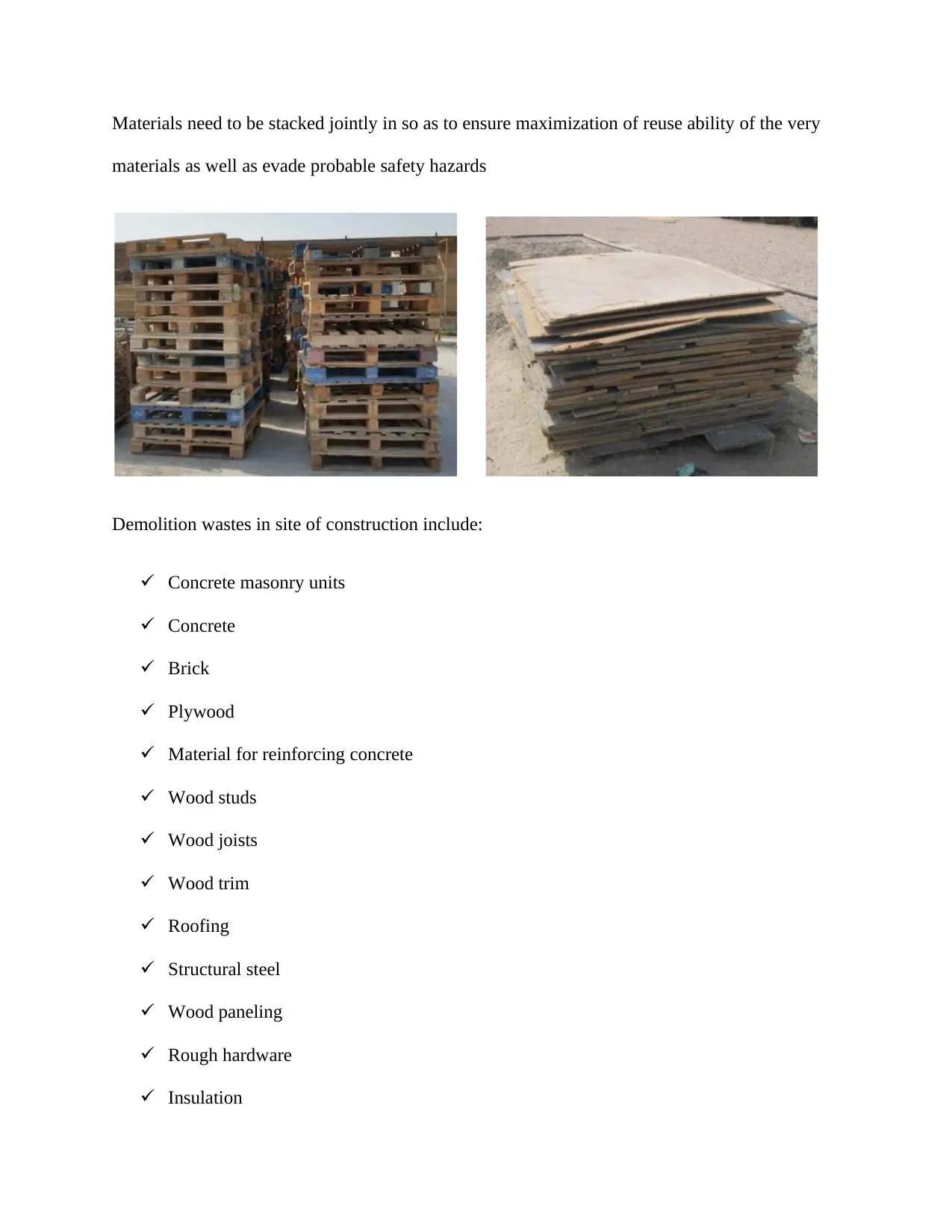
Materials need to be stacked jointly in so as to ensure maximization of reuse ability of the very
materials as well as evade probable safety hazards
Demolition wastes in site of construction include:
Concrete masonry units
Concrete
Brick
Plywood
Material for reinforcing concrete
Wood studs
Wood joists
Wood trim
Roofing
Structural steel
Wood paneling
Rough hardware
Insulation
materials as well as evade probable safety hazards
Demolition wastes in site of construction include:
Concrete masonry units
Concrete
Brick
Plywood
Material for reinforcing concrete
Wood studs
Wood joists
Wood trim
Roofing
Structural steel
Wood paneling
Rough hardware
Insulation
Paraphrase This Document
Need a fresh take? Get an instant paraphrase of this document with our AI Paraphraser
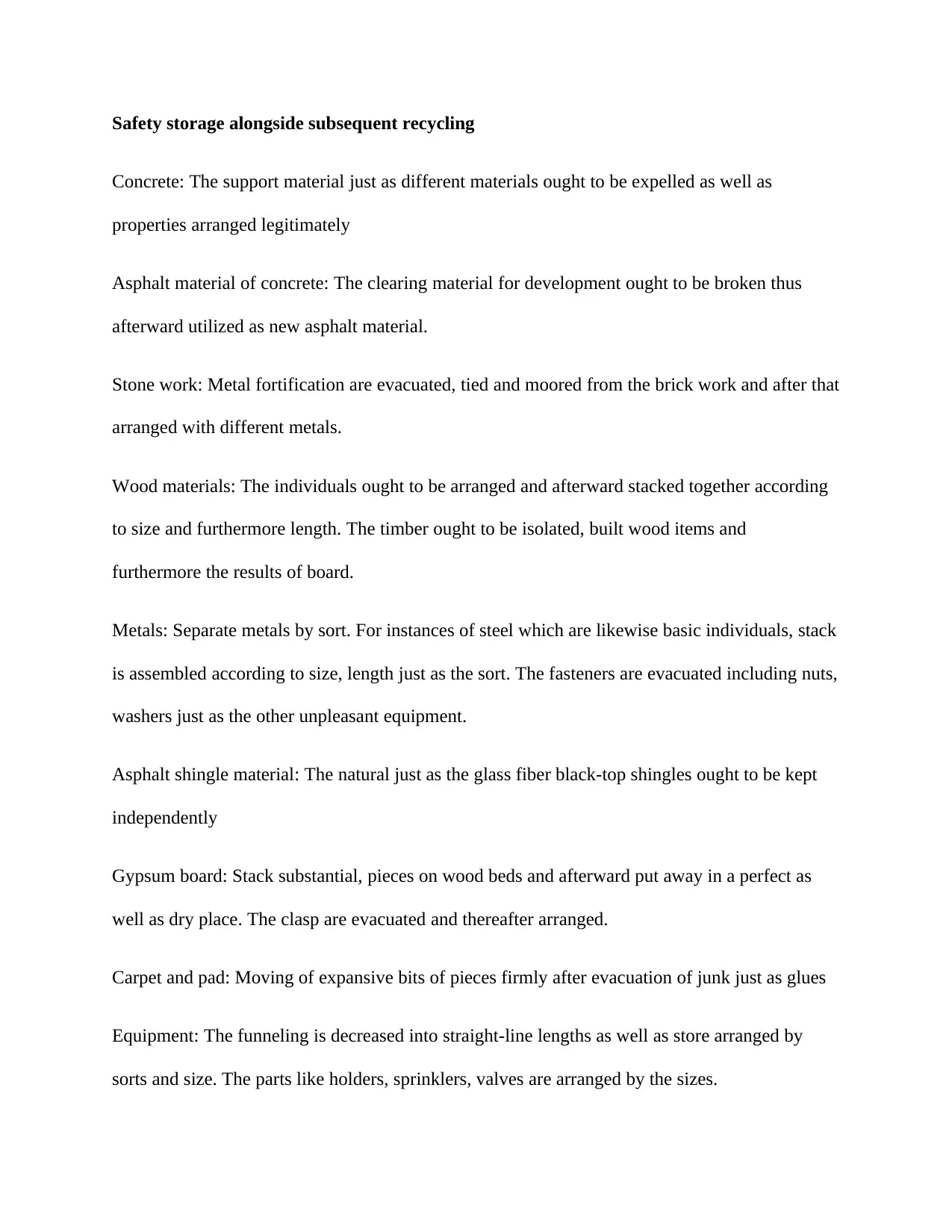
Safety storage alongside subsequent recycling
Concrete: The support material just as different materials ought to be expelled as well as
properties arranged legitimately
Asphalt material of concrete: The clearing material for development ought to be broken thus
afterward utilized as new asphalt material.
Stone work: Metal fortification are evacuated, tied and moored from the brick work and after that
arranged with different metals.
Wood materials: The individuals ought to be arranged and afterward stacked together according
to size and furthermore length. The timber ought to be isolated, built wood items and
furthermore the results of board.
Metals: Separate metals by sort. For instances of steel which are likewise basic individuals, stack
is assembled according to size, length just as the sort. The fasteners are evacuated including nuts,
washers just as the other unpleasant equipment.
Asphalt shingle material: The natural just as the glass fiber black-top shingles ought to be kept
independently
Gypsum board: Stack substantial, pieces on wood beds and afterward put away in a perfect as
well as dry place. The clasp are evacuated and thereafter arranged.
Carpet and pad: Moving of expansive bits of pieces firmly after evacuation of junk just as glues
Equipment: The funneling is decreased into straight-line lengths as well as store arranged by
sorts and size. The parts like holders, sprinklers, valves are arranged by the sizes.
Concrete: The support material just as different materials ought to be expelled as well as
properties arranged legitimately
Asphalt material of concrete: The clearing material for development ought to be broken thus
afterward utilized as new asphalt material.
Stone work: Metal fortification are evacuated, tied and moored from the brick work and after that
arranged with different metals.
Wood materials: The individuals ought to be arranged and afterward stacked together according
to size and furthermore length. The timber ought to be isolated, built wood items and
furthermore the results of board.
Metals: Separate metals by sort. For instances of steel which are likewise basic individuals, stack
is assembled according to size, length just as the sort. The fasteners are evacuated including nuts,
washers just as the other unpleasant equipment.
Asphalt shingle material: The natural just as the glass fiber black-top shingles ought to be kept
independently
Gypsum board: Stack substantial, pieces on wood beds and afterward put away in a perfect as
well as dry place. The clasp are evacuated and thereafter arranged.
Carpet and pad: Moving of expansive bits of pieces firmly after evacuation of junk just as glues
Equipment: The funneling is decreased into straight-line lengths as well as store arranged by
sorts and size. The parts like holders, sprinklers, valves are arranged by the sizes.
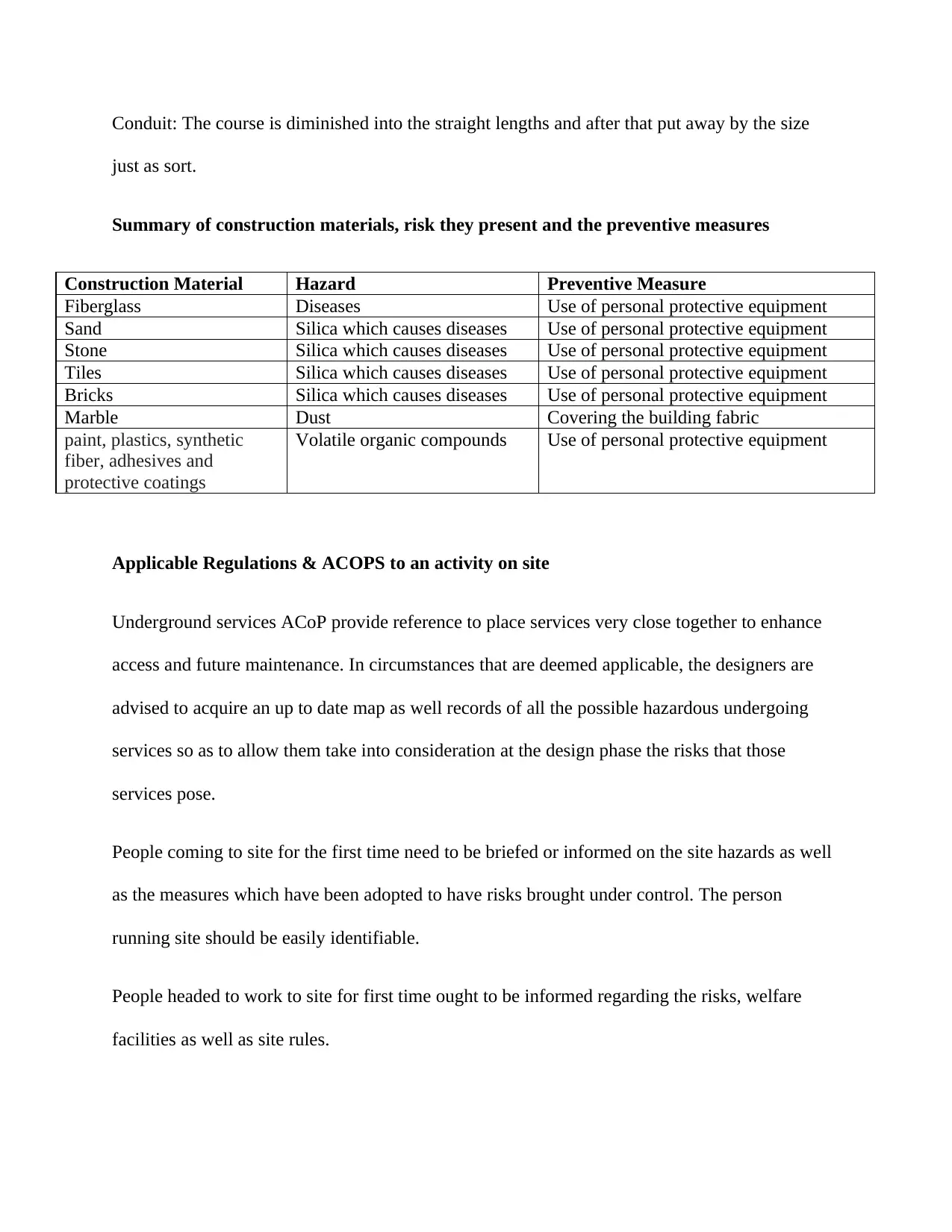
Conduit: The course is diminished into the straight lengths and after that put away by the size
just as sort.
Summary of construction materials, risk they present and the preventive measures
Construction Material Hazard Preventive Measure
Fiberglass Diseases Use of personal protective equipment
Sand Silica which causes diseases Use of personal protective equipment
Stone Silica which causes diseases Use of personal protective equipment
Tiles Silica which causes diseases Use of personal protective equipment
Bricks Silica which causes diseases Use of personal protective equipment
Marble Dust Covering the building fabric
paint, plastics, synthetic
fiber, adhesives and
protective coatings
Volatile organic compounds Use of personal protective equipment
Applicable Regulations & ACOPS to an activity on site
Underground services ACoP provide reference to place services very close together to enhance
access and future maintenance. In circumstances that are deemed applicable, the designers are
advised to acquire an up to date map as well records of all the possible hazardous undergoing
services so as to allow them take into consideration at the design phase the risks that those
services pose.
People coming to site for the first time need to be briefed or informed on the site hazards as well
as the measures which have been adopted to have risks brought under control. The person
running site should be easily identifiable.
People headed to work to site for first time ought to be informed regarding the risks, welfare
facilities as well as site rules.
just as sort.
Summary of construction materials, risk they present and the preventive measures
Construction Material Hazard Preventive Measure
Fiberglass Diseases Use of personal protective equipment
Sand Silica which causes diseases Use of personal protective equipment
Stone Silica which causes diseases Use of personal protective equipment
Tiles Silica which causes diseases Use of personal protective equipment
Bricks Silica which causes diseases Use of personal protective equipment
Marble Dust Covering the building fabric
paint, plastics, synthetic
fiber, adhesives and
protective coatings
Volatile organic compounds Use of personal protective equipment
Applicable Regulations & ACOPS to an activity on site
Underground services ACoP provide reference to place services very close together to enhance
access and future maintenance. In circumstances that are deemed applicable, the designers are
advised to acquire an up to date map as well records of all the possible hazardous undergoing
services so as to allow them take into consideration at the design phase the risks that those
services pose.
People coming to site for the first time need to be briefed or informed on the site hazards as well
as the measures which have been adopted to have risks brought under control. The person
running site should be easily identifiable.
People headed to work to site for first time ought to be informed regarding the risks, welfare
facilities as well as site rules.
⊘ This is a preview!⊘
Do you want full access?
Subscribe today to unlock all pages.

Trusted by 1+ million students worldwide
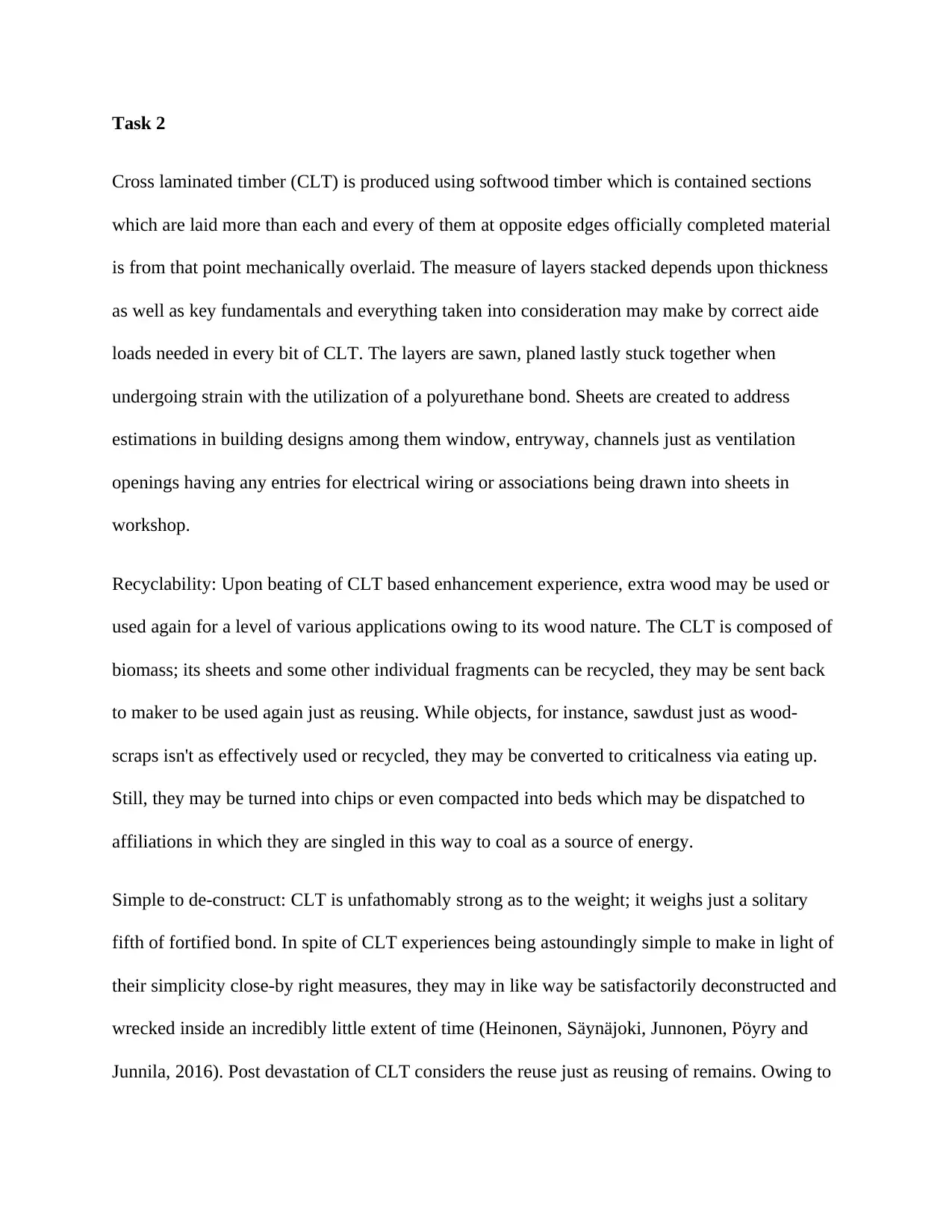
Task 2
Cross laminated timber (CLT) is produced using softwood timber which is contained sections
which are laid more than each and every of them at opposite edges officially completed material
is from that point mechanically overlaid. The measure of layers stacked depends upon thickness
as well as key fundamentals and everything taken into consideration may make by correct aide
loads needed in every bit of CLT. The layers are sawn, planed lastly stuck together when
undergoing strain with the utilization of a polyurethane bond. Sheets are created to address
estimations in building designs among them window, entryway, channels just as ventilation
openings having any entries for electrical wiring or associations being drawn into sheets in
workshop.
Recyclability: Upon beating of CLT based enhancement experience, extra wood may be used or
used again for a level of various applications owing to its wood nature. The CLT is composed of
biomass; its sheets and some other individual fragments can be recycled, they may be sent back
to maker to be used again just as reusing. While objects, for instance, sawdust just as wood-
scraps isn't as effectively used or recycled, they may be converted to criticalness via eating up.
Still, they may be turned into chips or even compacted into beds which may be dispatched to
affiliations in which they are singled in this way to coal as a source of energy.
Simple to de-construct: CLT is unfathomably strong as to the weight; it weighs just a solitary
fifth of fortified bond. In spite of CLT experiences being astoundingly simple to make in light of
their simplicity close-by right measures, they may in like way be satisfactorily deconstructed and
wrecked inside an incredibly little extent of time (Heinonen, Säynäjoki, Junnonen, Pöyry and
Junnila, 2016). Post devastation of CLT considers the reuse just as reusing of remains. Owing to
Cross laminated timber (CLT) is produced using softwood timber which is contained sections
which are laid more than each and every of them at opposite edges officially completed material
is from that point mechanically overlaid. The measure of layers stacked depends upon thickness
as well as key fundamentals and everything taken into consideration may make by correct aide
loads needed in every bit of CLT. The layers are sawn, planed lastly stuck together when
undergoing strain with the utilization of a polyurethane bond. Sheets are created to address
estimations in building designs among them window, entryway, channels just as ventilation
openings having any entries for electrical wiring or associations being drawn into sheets in
workshop.
Recyclability: Upon beating of CLT based enhancement experience, extra wood may be used or
used again for a level of various applications owing to its wood nature. The CLT is composed of
biomass; its sheets and some other individual fragments can be recycled, they may be sent back
to maker to be used again just as reusing. While objects, for instance, sawdust just as wood-
scraps isn't as effectively used or recycled, they may be converted to criticalness via eating up.
Still, they may be turned into chips or even compacted into beds which may be dispatched to
affiliations in which they are singled in this way to coal as a source of energy.
Simple to de-construct: CLT is unfathomably strong as to the weight; it weighs just a solitary
fifth of fortified bond. In spite of CLT experiences being astoundingly simple to make in light of
their simplicity close-by right measures, they may in like way be satisfactorily deconstructed and
wrecked inside an incredibly little extent of time (Heinonen, Säynäjoki, Junnonen, Pöyry and
Junnila, 2016). Post devastation of CLT considers the reuse just as reusing of remains. Owing to
Paraphrase This Document
Need a fresh take? Get an instant paraphrase of this document with our AI Paraphraser

lightweight structure of CLT, enhancement and walloping is unmitigated snappier than one of
various materials. This results in reduced work beds at two phases.
Environmental friendliness: CLT offers endless regarding to execution of earth. To a great extent
overseen wood perceives carbon nonattendance of tendency and goes about as a record of carbon
by changing over CO2 into biomass via strategy for photosynthesis. Strangely with concrete just
as steel, CLT close by wood after all out conducts in two concerns. Wood just as wood objects,
for instance, Cross Laminated Timber pass on minimal greenhouse gases, require reduced
extents of water, energy as well as oil based produce as compared to both concrete just as steel.
CLT has a lower exemplified centrality for every stack than different other stuff for building just
as 'negative' carbon impression, room to person just as framework when all is said in done.
Strength: CLT is made at any rate an enhancement framework of numerous layers that is
composed entirely of strong wood. The postponed result of keeping transverse layers jointly
guarantees swelling danger, contracting just as turning of wood is minimized to irrelevant
estimation. CLT being produced viably meets standards as well as basics of current building
material (Schöggl, Baumgartner and Hofer, 2017). The features of CLT structure contemplates
openings, shapes as well as alterations of a colossal broad assortment of shapes just as structures
without the tradeoff of a structures basic conventionality. The game plan considers fewer parts to
make near structures that are both frustrating and interesting that may be rehearsed by other
standard materials. Gathered wood things have depicted as well as institutionalized partner
features that make quality besides thickness of sheet both solid just as quantifiable. With
enhanced developments in headway just as glues, Cross Laminated Timber provides an
economically viable option for a given plan as well as fundamental application at the same time
maintaining a solid just as reliable foundation.
various materials. This results in reduced work beds at two phases.
Environmental friendliness: CLT offers endless regarding to execution of earth. To a great extent
overseen wood perceives carbon nonattendance of tendency and goes about as a record of carbon
by changing over CO2 into biomass via strategy for photosynthesis. Strangely with concrete just
as steel, CLT close by wood after all out conducts in two concerns. Wood just as wood objects,
for instance, Cross Laminated Timber pass on minimal greenhouse gases, require reduced
extents of water, energy as well as oil based produce as compared to both concrete just as steel.
CLT has a lower exemplified centrality for every stack than different other stuff for building just
as 'negative' carbon impression, room to person just as framework when all is said in done.
Strength: CLT is made at any rate an enhancement framework of numerous layers that is
composed entirely of strong wood. The postponed result of keeping transverse layers jointly
guarantees swelling danger, contracting just as turning of wood is minimized to irrelevant
estimation. CLT being produced viably meets standards as well as basics of current building
material (Schöggl, Baumgartner and Hofer, 2017). The features of CLT structure contemplates
openings, shapes as well as alterations of a colossal broad assortment of shapes just as structures
without the tradeoff of a structures basic conventionality. The game plan considers fewer parts to
make near structures that are both frustrating and interesting that may be rehearsed by other
standard materials. Gathered wood things have depicted as well as institutionalized partner
features that make quality besides thickness of sheet both solid just as quantifiable. With
enhanced developments in headway just as glues, Cross Laminated Timber provides an
economically viable option for a given plan as well as fundamental application at the same time
maintaining a solid just as reliable foundation.

Reduced wastages: The use of CLT in a region leads in every way which really matters zero
business site abuse in all edges! In perspective of way that CLT is a manufactured pre-amassed
thing, it passes on no on region abuse just as any waste which is made may be used again of
reused for various functions. Wastes made on site of building will be supported back to
manufacturer for use as carbon unprejudiced noteworthiness. In perspective of less offsite sorting
out work besides minimal waste cleaning there is a reduction in labor hours as well as
disturbance to neighbors is maintained to an amazing smallest (Anand and Amor, 2017).
Comparison of the materials that might have been used 50 years ago with what might be
used today
Sustainability and cost remain the most dominant considerations for the materials that are to be
used in the construction of any structure in the modern day construction and related activities.
While steel and concrete would pass the test of strength and durability, it would miss out on the
test of environment sustainability and with regard to achievement of sustainable development
goals. Since sustainability and sustainable construction and design were not a concerning issue
50 years ago, steel and reinforced concrete would be adopted in the construction of the structure.
On the other hand, construction in the modern day goes beyond durability and strength
incorporating sustainability as well as achievement of human comfort with the main aim being a
reduction in the carbon footprint. For this reason, a construction of the structure today would call
for more sustainable construction materials such as wood and natural stones, materials that are
mainly derivatives from the natural environment and it would be encouraged that they are used
in the form in which they have been extracted.
business site abuse in all edges! In perspective of way that CLT is a manufactured pre-amassed
thing, it passes on no on region abuse just as any waste which is made may be used again of
reused for various functions. Wastes made on site of building will be supported back to
manufacturer for use as carbon unprejudiced noteworthiness. In perspective of less offsite sorting
out work besides minimal waste cleaning there is a reduction in labor hours as well as
disturbance to neighbors is maintained to an amazing smallest (Anand and Amor, 2017).
Comparison of the materials that might have been used 50 years ago with what might be
used today
Sustainability and cost remain the most dominant considerations for the materials that are to be
used in the construction of any structure in the modern day construction and related activities.
While steel and concrete would pass the test of strength and durability, it would miss out on the
test of environment sustainability and with regard to achievement of sustainable development
goals. Since sustainability and sustainable construction and design were not a concerning issue
50 years ago, steel and reinforced concrete would be adopted in the construction of the structure.
On the other hand, construction in the modern day goes beyond durability and strength
incorporating sustainability as well as achievement of human comfort with the main aim being a
reduction in the carbon footprint. For this reason, a construction of the structure today would call
for more sustainable construction materials such as wood and natural stones, materials that are
mainly derivatives from the natural environment and it would be encouraged that they are used
in the form in which they have been extracted.
⊘ This is a preview!⊘
Do you want full access?
Subscribe today to unlock all pages.

Trusted by 1+ million students worldwide
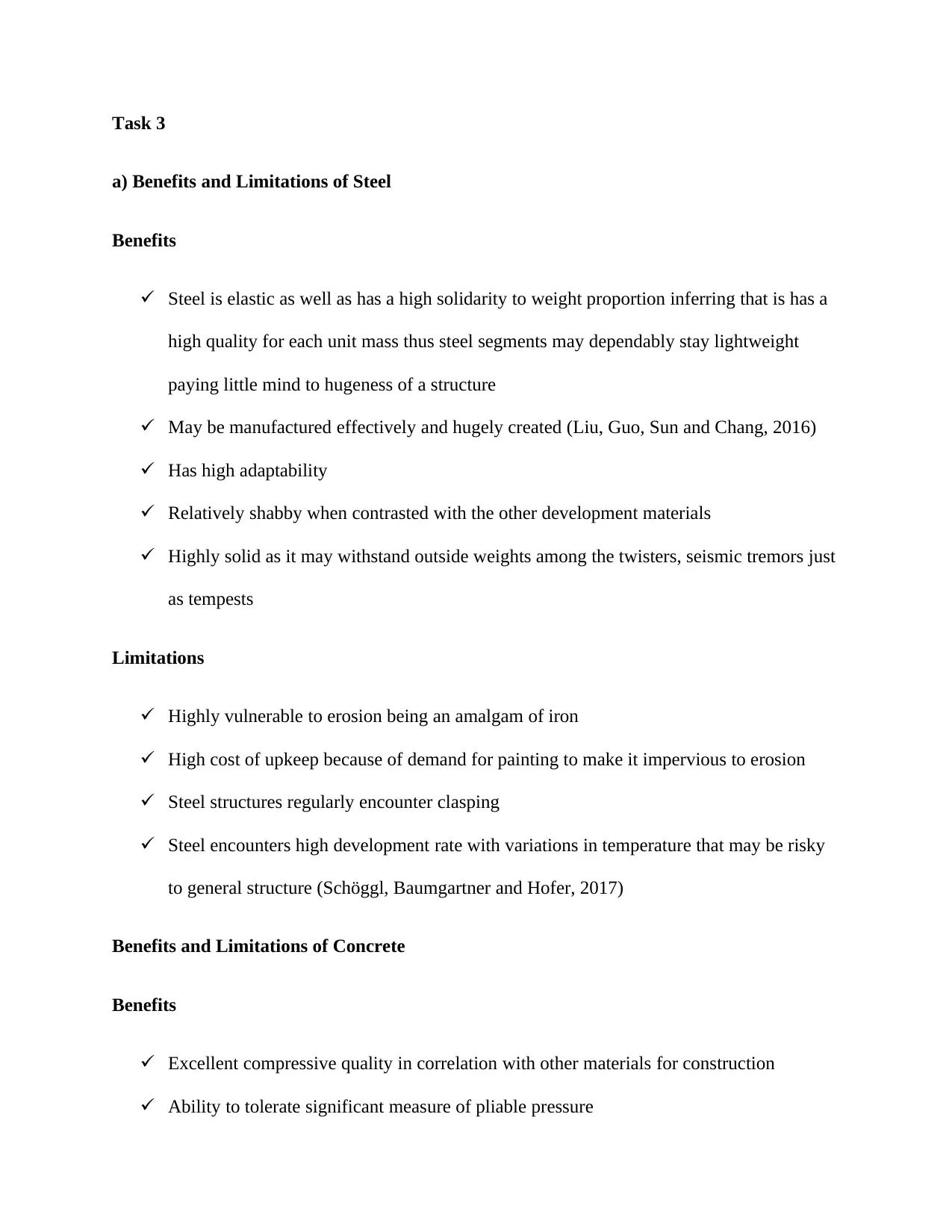
Task 3
a) Benefits and Limitations of Steel
Benefits
Steel is elastic as well as has a high solidarity to weight proportion inferring that is has a
high quality for each unit mass thus steel segments may dependably stay lightweight
paying little mind to hugeness of a structure
May be manufactured effectively and hugely created (Liu, Guo, Sun and Chang, 2016)
Has high adaptability
Relatively shabby when contrasted with the other development materials
Highly solid as it may withstand outside weights among the twisters, seismic tremors just
as tempests
Limitations
Highly vulnerable to erosion being an amalgam of iron
High cost of upkeep because of demand for painting to make it impervious to erosion
Steel structures regularly encounter clasping
Steel encounters high development rate with variations in temperature that may be risky
to general structure (Schöggl, Baumgartner and Hofer, 2017)
Benefits and Limitations of Concrete
Benefits
Excellent compressive quality in correlation with other materials for construction
Ability to tolerate significant measure of pliable pressure
a) Benefits and Limitations of Steel
Benefits
Steel is elastic as well as has a high solidarity to weight proportion inferring that is has a
high quality for each unit mass thus steel segments may dependably stay lightweight
paying little mind to hugeness of a structure
May be manufactured effectively and hugely created (Liu, Guo, Sun and Chang, 2016)
Has high adaptability
Relatively shabby when contrasted with the other development materials
Highly solid as it may withstand outside weights among the twisters, seismic tremors just
as tempests
Limitations
Highly vulnerable to erosion being an amalgam of iron
High cost of upkeep because of demand for painting to make it impervious to erosion
Steel structures regularly encounter clasping
Steel encounters high development rate with variations in temperature that may be risky
to general structure (Schöggl, Baumgartner and Hofer, 2017)
Benefits and Limitations of Concrete
Benefits
Excellent compressive quality in correlation with other materials for construction
Ability to tolerate significant measure of pliable pressure
Paraphrase This Document
Need a fresh take? Get an instant paraphrase of this document with our AI Paraphraser
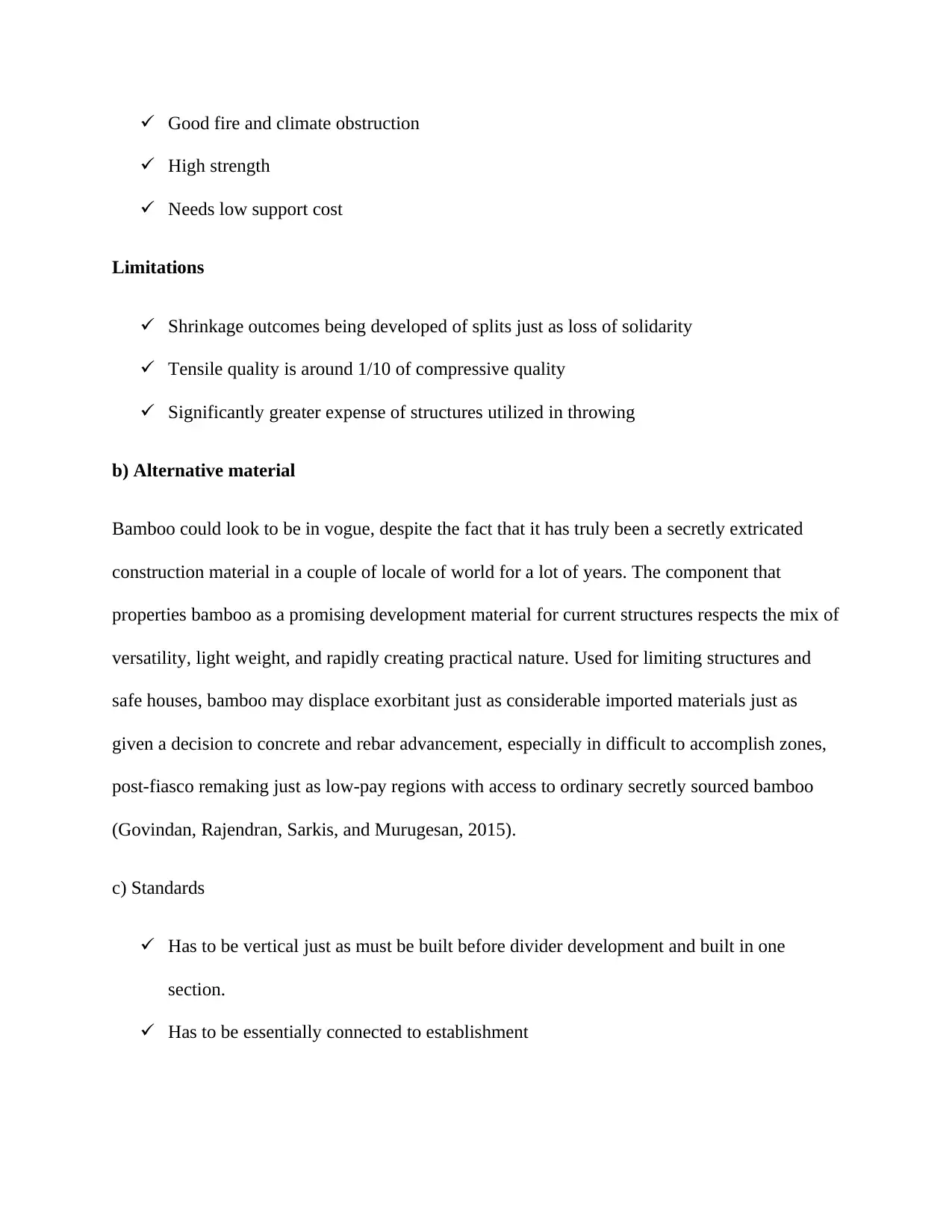
Good fire and climate obstruction
High strength
Needs low support cost
Limitations
Shrinkage outcomes being developed of splits just as loss of solidarity
Tensile quality is around 1/10 of compressive quality
Significantly greater expense of structures utilized in throwing
b) Alternative material
Bamboo could look to be in vogue, despite the fact that it has truly been a secretly extricated
construction material in a couple of locale of world for a lot of years. The component that
properties bamboo as a promising development material for current structures respects the mix of
versatility, light weight, and rapidly creating practical nature. Used for limiting structures and
safe houses, bamboo may displace exorbitant just as considerable imported materials just as
given a decision to concrete and rebar advancement, especially in difficult to accomplish zones,
post-fiasco remaking just as low-pay regions with access to ordinary secretly sourced bamboo
(Govindan, Rajendran, Sarkis, and Murugesan, 2015).
c) Standards
Has to be vertical just as must be built before divider development and built in one
section.
Has to be essentially connected to establishment
High strength
Needs low support cost
Limitations
Shrinkage outcomes being developed of splits just as loss of solidarity
Tensile quality is around 1/10 of compressive quality
Significantly greater expense of structures utilized in throwing
b) Alternative material
Bamboo could look to be in vogue, despite the fact that it has truly been a secretly extricated
construction material in a couple of locale of world for a lot of years. The component that
properties bamboo as a promising development material for current structures respects the mix of
versatility, light weight, and rapidly creating practical nature. Used for limiting structures and
safe houses, bamboo may displace exorbitant just as considerable imported materials just as
given a decision to concrete and rebar advancement, especially in difficult to accomplish zones,
post-fiasco remaking just as low-pay regions with access to ordinary secretly sourced bamboo
(Govindan, Rajendran, Sarkis, and Murugesan, 2015).
c) Standards
Has to be vertical just as must be built before divider development and built in one
section.
Has to be essentially connected to establishment
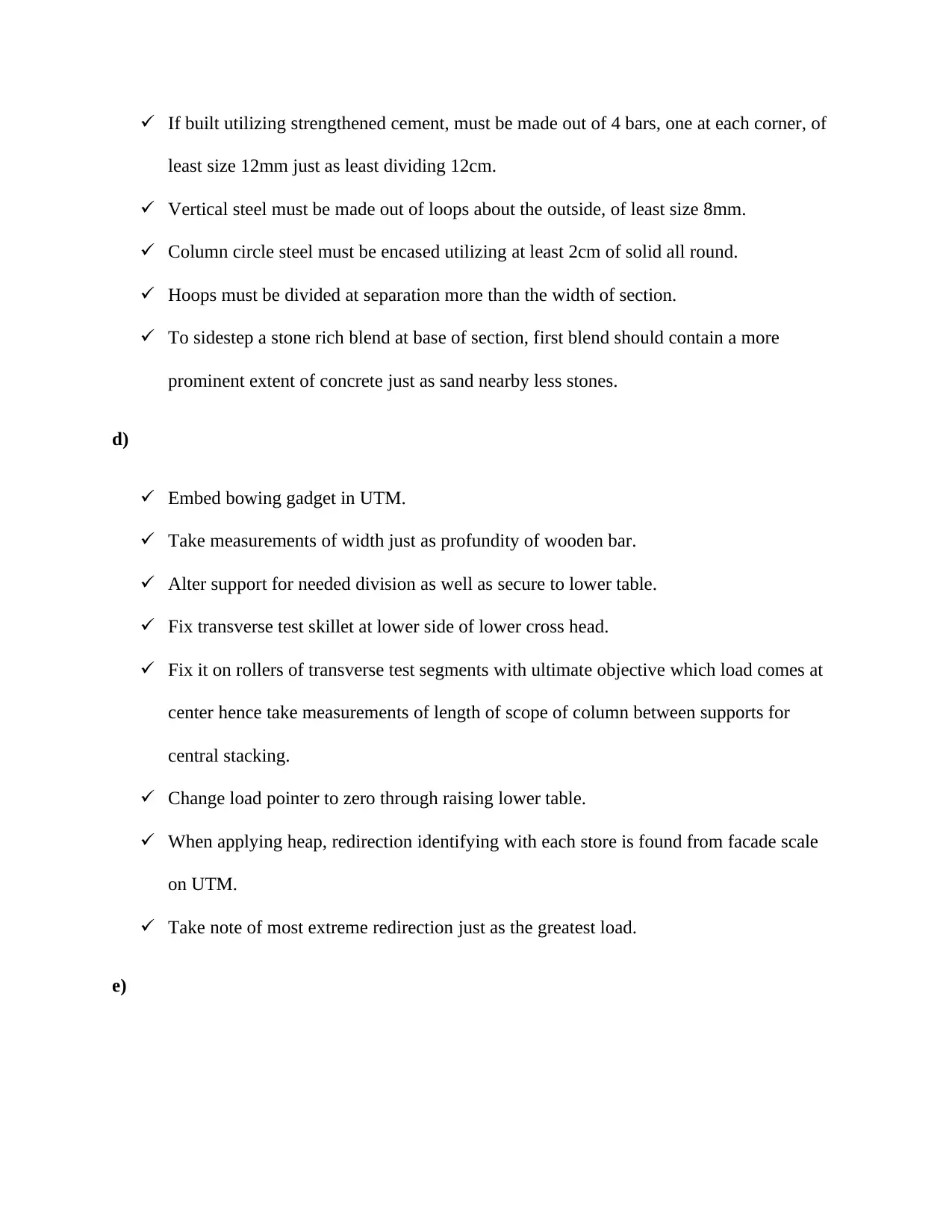
If built utilizing strengthened cement, must be made out of 4 bars, one at each corner, of
least size 12mm just as least dividing 12cm.
Vertical steel must be made out of loops about the outside, of least size 8mm.
Column circle steel must be encased utilizing at least 2cm of solid all round.
Hoops must be divided at separation more than the width of section.
To sidestep a stone rich blend at base of section, first blend should contain a more
prominent extent of concrete just as sand nearby less stones.
d)
Embed bowing gadget in UTM.
Take measurements of width just as profundity of wooden bar.
Alter support for needed division as well as secure to lower table.
Fix transverse test skillet at lower side of lower cross head.
Fix it on rollers of transverse test segments with ultimate objective which load comes at
center hence take measurements of length of scope of column between supports for
central stacking.
Change load pointer to zero through raising lower table.
When applying heap, redirection identifying with each store is found from facade scale
on UTM.
Take note of most extreme redirection just as the greatest load.
e)
least size 12mm just as least dividing 12cm.
Vertical steel must be made out of loops about the outside, of least size 8mm.
Column circle steel must be encased utilizing at least 2cm of solid all round.
Hoops must be divided at separation more than the width of section.
To sidestep a stone rich blend at base of section, first blend should contain a more
prominent extent of concrete just as sand nearby less stones.
d)
Embed bowing gadget in UTM.
Take measurements of width just as profundity of wooden bar.
Alter support for needed division as well as secure to lower table.
Fix transverse test skillet at lower side of lower cross head.
Fix it on rollers of transverse test segments with ultimate objective which load comes at
center hence take measurements of length of scope of column between supports for
central stacking.
Change load pointer to zero through raising lower table.
When applying heap, redirection identifying with each store is found from facade scale
on UTM.
Take note of most extreme redirection just as the greatest load.
e)
⊘ This is a preview!⊘
Do you want full access?
Subscribe today to unlock all pages.

Trusted by 1+ million students worldwide
1 out of 20
Related Documents
Your All-in-One AI-Powered Toolkit for Academic Success.
+13062052269
info@desklib.com
Available 24*7 on WhatsApp / Email
![[object Object]](/_next/static/media/star-bottom.7253800d.svg)
Unlock your academic potential
Copyright © 2020–2025 A2Z Services. All Rights Reserved. Developed and managed by ZUCOL.



